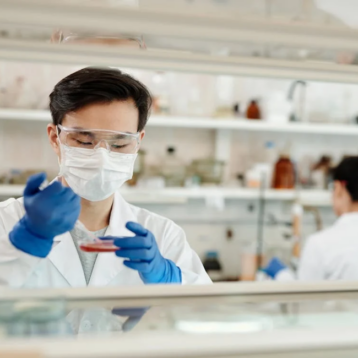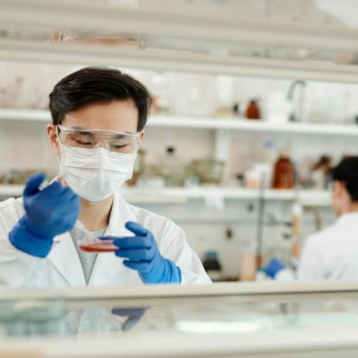From discovering extrasolar planets to revealing new insights into the workings of life-threatening diseases such as cancer, AIDS, and Alzheimers, 2006 was a year full of scientific innovation. In this article, TFOT returns to a few of the most interesting science, medical, and space related stories it covered over the passing year.
Today TFOT begins a tradition of summarizing some of the most interesting stories published on the site in the passing year in science, medicine, and space.
Science
 |
Caulobacter crescentus
produces nature’s strongest super glue |
|
In an article published in the journal PNAS in March 2006, Yves V. Brun and colleagues from Indiana University discovered what could be nature’s strongest “super glue”, produced by a hydrophilic bacterial strain, with a myriad of applications ranging from emergency wound-healing to mending damaged vessels at sea.
 |
| The Compact Muon Solenoid |
|
Important advances were made in one of the largest scientific projects currently underway in the world – the Large Hadron Collider (LHC) under construction at the CERN Laboratory in Switzerland. Two of the four detectors that are part of the 27 km (~17 mi.) long accelerator are nearing completion. The ATLAS detector saw the final stages of the work on its gigantic Barrel Toroid superconducting magnet. Measuring 5 m x 25 m and weighing 100 tons, it is the largest superconducting magnet ever built. The Compact Muon Solenoid (CMS) detector, weighing 12,500 tons and twice as heavy as the ATLAS detector, is also in the
 |
2006 Nobel in Physics awarded
to John C. Mather
(left) and George F. Smoot |
|
final stages of construction. Both of these detectors will make it possible for scientists to try to prove the existence of new particles such as the Higgs boson particle, supersymmetric particles, mini-black holes, and even gravitons and will address fundamental questions about the universe, such as the origin of mass, how many dimensions there are, and what constitutes dark matter. As always, Nobel Prizes were awarded in three scientific fields in 2006. In physics, John C. Mather of the NASA Goddard Space Flight Center and George F. Smoot of the University of California, Berkeley received the award for “work that looks back into the infancy of the Universe and attempts to gain some understanding of the origin of galaxies and stars. It is based on measurements made with the help of the COBE satellite launched by NASA in 1989.”
 |
2006 Nobel Prize in Physiology or Medicine awarded to
Andrew Z. Fire and Craig C. |
|
The 2006 Nobel Prize in Chemistry was awarded to Roger D. Kornberg from Stanford University for his “studies of the molecular basis of eukaryotic transcription”.
In Physiology or Medicine, the Nobel prize was shared by Professor Andrew Z. Fire from Stanford University, California and Professor Craig C. Mello from the University of Massachusetts Medical School in Worcester. They were recognized for their discovery published in 1998 that double-stranded RNA triggers suppression of gene activity in a homology-dependent manner, a process named RNA interference (RNAi).
Medicine
In 2006, TFOT covered several innovative developments in medicine. One report covered the development by researchers from Caltech (California Institute of Technology) of a micro-sized laboratory (or so–called “lab-on-a-chip”) capable of analyzing minute blood samples to determine the exact levels of red and white blood cells as well as other blood components. Funded by NASA, the research was aimed at creating a small device capable of performing simple blood tests in space for astronauts of the future.
 |
| Luminetx VeinViewer |
|
Another innovative medical related technology that entered the market in 2006 is the Luminetx VeinViewer that allows medical professionals a quick and convenient look at a patient’s vasculature using a near-infrared LED (light emitting diode) source, which differentiates red blood cells of subcutaneous veins from surrounding tissues and arteries.
In 2006, TFOT also reported on some innovative research that improved our understanding of several life-threatening diseases. Collaboration between neuroscientists at several universities in the U.S. led to the discovery of a protein complex that appears to cause cognitive decline and loss of memory. This finding will provide a potential target for prevention of dementia associated with Alzheimer’s disease and may enhance early diagnosis.
In an AIDS-related study, TFOT covered the discovery by researchers at Ohio State University of
two human nuclear proteins that might protect cells against HIV.
 |
| PillCam colon video capsule |
|
Completing the trio of disease studies is cancer-related research conducted at the Cleveland Clinic Lerner College of Medicine in Ohio that showed that when tumor cells resistant to chemotherapeutic drugs were subjected to very low intensity electrical stimulation, the cells acquired sensitivity to the anti-cancer drug doxorubicin. This effect has the potential to reform treatment especially for malignant tumors that are refractory to drug treatment, while possibly reducing side effects in all patients undergoing chemotherapy.
One medical gadget covered was the PillCam Colon Video Capsule Endoscope developed by the Israeli company Given Imaging, shown to detect polyps not found by colonoscopy. Roughly the size of a large vitamin pill, the PillCam is relatively easy to swallow and passes painlessly through the gastrointestinal system, while taking photographs of the large intestine.
Space
 |
| Antimatter engine |
|
In 2006, TFOT covered a large and varied array of space-related stories. One was a story on a new form of space propulsion technology based on positrons developed by a team of scientists working with NASA. This revolutionary antimatter engine might require only a few milligrams of positrons to send a spaceship to Mars.
We also covered another unique concept for a space fuel proposed by a team of scientists in Israel to develop a power source for space vehicles and other space-based applications such as the International Space Station. This new battery-like device includes a core of americium 242, which generates a very efficient fission reaction and will be able to power the space station for approximately 80 days before requiring refueling.
 |
| Merging galaxies |
|
The Hubble space telescope, which NASA decided to keep operational until 2013, was the subject of extensive coverage. From discovering 16 extrasolar planet candidates orbiting a variety of distant stars in the central region of our Milky Way galaxy to images of merging galaxies and newly born stars in the Orion nebula, Hubble produced a tremendous amount of beautiful and telling new pictures of our universe.
Several other important space-related discoveries were made in 2006, including the first ever measurements of the day and night temperatures of a planet outside our solar system conducted by NASA’s Spitzer Space Telescope, as well as stronger evidence for running water on the surface of Mars within the last several years, captured by the Mars Orbiter Camera on NASA’s Mars Global Surveyor.
 |
| STS-116 nighttime launch |
|
2006 was also the year when NASA’s space shuttle returned to space. In July, Mission STS-121 on the Space Shuttle Discovery delivered supplies, and made repairs to the International Space Station. STS-115 saw the Space Shuttle Atlantis resuming assembly of the International Space Station in September. Mission STS-116 on Discovery in December was the third and final shuttle launch of 2006 and the first nighttime launch in four years since the doomed Columbia mission.
 |
| Cape Cod and the Islands from space |
|
TFOT also covered several images taken by the crew of the Atlantis and Discovery space shuttles. A wonderful photograph with an aerial view of Cape Cod and “the Islands” from 220 miles above the earth was taken by Dan Burbank on mission STS-115. Visible are the entirety of “the Cape” and the islands of Martha’s Vineyard (left) and Nantucket (right), as well as well north of and including Boston, and to the south, part of Long island up to Montauk at its tip. An aerial photograph of greater San Diego was snapped during the same mission on the Space Shuttle Atlantis with a view that spans ~50 miles north to south from just below Oceanside at the top of the photograph to Tijuana, Mexico at the bottom. The Aurora Borealis (better known as the Northern Lights) was photographed by an STS-116 crew member aboard Space Shuttle Discovery. City lights and stars are also visible in this image from space because of the long camera exposure. Images of the aurora from space are the most spectacular because of the ability to capture the entire aurora.





















